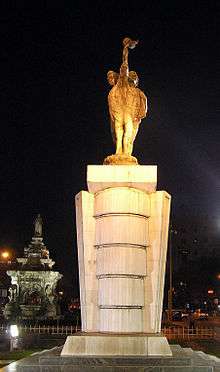Samyukta Maharashtra Movement

Samyukta Maharashtra Movement (or Sanyukta Maharashtra Andolan) (Marathi: संयुक्त महाराष्ट्र आंदोलन) was an organisation that demanded starting in 1956 for the creation of a separate Marathi-speaking state out of the (then-bilingual) State of Bombay in western India, with the city of Bombay as its capital.[1] Similarly, in 1956 the Mahagujarat Movement started agitation for creation of separate Gujarati-speaking State out of Bombay State, which became the state of Gujarat.
The Samyukta Maharashtra Movement achieved its aim when the present state of Maharashtra was created on May 1, 1960. The state reorganization left Marathi-speaking areas in Northern Karnataka, such as Belgaon, outside of Maharashtra. The newly liberated people of Goa voted against joining Mahararashtra as well.
History
The organisation was founded on February 6, 1956, under the leadership of Keshavrao Jedhe in Pune. Prominent activists of Samyukta Maharashtra Samiti were Maina Gawankar, Patramaharshi Dainik Prabhatkar Walchand Kothari, Acharya Atre, Prabodhankar Thackeray, Senapati Bapat, Bhai Uddhavrao Patil and Shahir AmarShaikh among others. Acharya Atre criticised Jawaharlal Nehru, Morarji Desai (then chief minister of Mumbai) and S.K. Patil through his firebrand editorials in Maratha.
The Indian National Congress had pledged to introduce linguistic states prior to Independence. However after Independence, Nehru and Sardar Vallabhbhai Patel were adamantly opposed to linguistic states. They perceived linguistic states as a threat to the integrity of India. For the first time and perhaps the only time, Rashtriya Swayamsevak Sangh (RSS) and its chief Madhav Sadashiv Golwalkar supported Nehru and Patel against redrawing of the map along linguistic lines. The catalyst to the creation of a States Re-organization Commission was the fasting death of Telugu nationalist Potti Sriramulu. In 1956, the SRC (States Re-organisation Committee) recommended creation of linguistic states of Andhra Pradesh, Kerala and Karnataka but recommended a bi-lingual state for Maharashtra-Gujarat, with Mumbai as its capital but vidarbha outside Maharashtra. Further, they recommended the creation of Vidharba state to unite the Marathi-speaking people of former Hyderabad state with Marathi-speaking areas of Central Provinces and Berar state. This led to the creation of the predecessor movement Sanyuka Maharashtra Parishad, inaugurated on November 1, 1956, causing a great political stir and, under the leadership of Keshavrao Jedhe, a whole party meeting was held in Pune and Samyukta Maharashtra Samiti was founded on February 6, 1956. In the second general election the Samiti defeated the stalwarts of Congress by securing 101 seats out of 133, including 12 from Mumbai. The Congress party could form a government only with the support of Gujarat, Marathwada and Vidharba. Yeshwantrao Chavan replaced Morarji Desai as the Chief Minister of the bi-lingual Bombay State.
S.M. Joshi, Shripad Amrit Dange, Nanasaheb Gore, Prahlad Keshav Atre, and Bhai Uddhavrao Patil fought relentlessly for Samyukta Maharashtra, even at the cost of sacrificing the lives of several people and finally succeeded in convincing Congress leaders that Maharashtra should form a separate state. The resignation of C. D. Deshmukh, the then Finance Minister of the Nehru Cabinet, had its salutary effect.
In January 1960, demonstrators were fired upon by the police at Flora Fountain in the capital city of Mumbai. Flora Fountain was subsequently renamed Hutatma Chowk or "Martyr's Crossroad" in their memory. It is estimated that in all, 105 people were shot by security forces during the period of agitation and at different places. Morarji Desai, who was the then chief minister of Bombay state was later removed and replaced by Yashwantrao Chavan as a result of criticism related to this incident.[2]
The Samyukta Maharashtra Samiti achieved its goal on May 1, 1960, when the State of Bombay was partitioned into the Marathi-speaking State of Maharashtra and the Gujarati-speaking State of Gujarat. However Goa (then a Portuguese colony), Belgaum, Karwar and adjoining areas, which were also part of the Maharashtra envisaged by the Samiti, were not included in Maharashtra state. the prominent leaders of sanyukt maharashtra samiti decided to quit samiti after 1 May 1960, but the then chairman of the samiti Bhai Uddavrao Patil continued his fight for the 862 Marathi-speaking villages of karnataka that were excluded in 1960.
See also
- Hutatma Chowk
- States Reorganisation Act
- Bombay State
- Mahagujarat Movement
- Goa Opinion Poll
- Chronology of statehood of Maharashtra
References
- ↑ Dialogue with Life - Madhu Dandavate - Google Books. Books.google.com.ni. Retrieved on 2013-07-29.
- ↑ BMC will give jobs to kin of Samyukta Maharashtra martyrs
External links
- Samyukta Maharashtra movement
- Founding of the Samiti
- 'Zalach Pahije!' by P.K. Atre ISBN 81-86837-00-0
| ||||||||||||||||||||||||||||||||||||||||||||||||||||
| ||||||||||||||||||||||||||||||